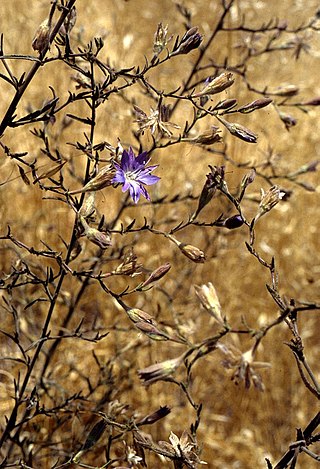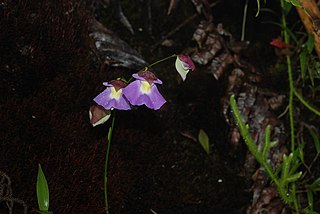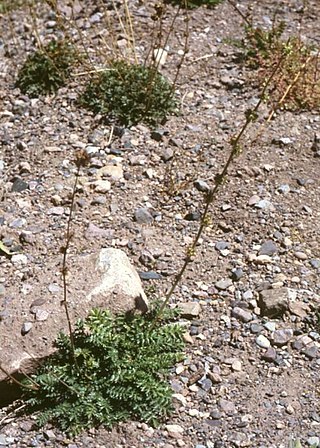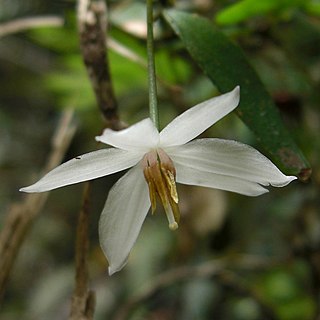
Malesherbia is a genus of flowering plants consisting of 25 species in the Passifloraceae. This is a xerophytic group endemic to the Peruvian and Chilean deserts and adjacent Argentina. The genus is currently recognized by the APG III system of classification in the family Passifloraceae, and is the sole member of the subfamily Malesherbioideae.

Campomanesia is a genus in the family Myrtaceae described as a genus in 1794. It is native to South America and Trinidad.

Soliva is a genus of South American plants in the sunflower family. Burrweed is a common name for some species in this genus.

Hipólito Ruiz López, or Hipólito Ruiz, was a Spanish botanist known for researching the floras of Peru and Chile during an expedition under Carlos III from 1777 to 1788. During the reign of Carlos III, three major botanical expeditions were sent to the New World; Ruiz and José Antonio Pavón Jiménez were the botanists for the first of these expeditions, to Peru and Chile.

Galinsoga is a genus of flowering plants in the family Asteraceae. It is native to North and South America and the West Indies, and naturalized in Europe, Asia, Africa, and Australia.

José Antonio Pavón Jiménez or José Antonio Pavón was a Spanish botanist known for researching the flora of Peru and Chile.

Utricularia unifolia is a species of perennial, medium-sized carnivorous plant that belongs to the family Lentibulariaceae. U. unifolia is native to Central America and western South America. It was originally published and described by Hipólito Ruiz López and José Antonio Pavón Jiménez in 1797 and later considered a synonym of Utricularia alpina until Peter Taylor's 1989 monograph on the genus where he restored the species as distinct from U. alpina. It grows as a terrestrial or epiphytic plant on moss-covered trees, rocks, or banks in cloud forests at altitudes between 2,000 m (6,562 ft) and 3,000 m (9,843 ft). U. unifolia usually produces only one leaf, which is where the species epithet "unifolia" is derived from.

Conanthera is a genus of small bulbous plants with small panicles of blue, purple or white and purple flowers. Propagation is by offsets or seed. All species are native to Chile, but there is an old 18th-Century report of C. bifolia occurring in colonial Peru as well. This could possibly be attributed to changes in boundaries between the two countries, as modern sources list the species as endemic to Chile.
- Conanthera bifoliaRuiz & Pav. - from Valparaíso to La Araucanía
- Conanthera campanulataLindl. - from Antofagasta to La Araucanía
- Conanthera parvula(Phil.) Muñoz-Schick - from Valparaíso to La Araucanía
- Conanthera trimaculata(D.Don) F.Meigen - central Chile
- Conanthera urceolataRavenna - Atacama

Salvia oppositiflora is a species of perennial flowering plant in the famiily Lamiaceae. It is native to Peru, growing at high elevations—7,000 to 12,000 feet. It was collected in 1798 by Hipólito Ruiz López and José Antonio Pavón Jiménez and later described in Flora of Peru.

Salvia sagittata is a species of herbaceous perennial plant in the family Lamiaceae. It is native to the Andes Mountains, growing at elevations from 9,500 to 10,500 ft. The specific epithet refers to the arrow-shaped leaves. The plant was collected and named in 1798 by Hipólito Ruiz López and José Antonio Pavón Jiménez, two Spanish botanists who spent ten years in Peru and Chile on a commission by the government of Spain to go to the New World in search of new medicinal and agricultural plants.

Epidendrum coronatum is a reed-stemmed epiphytic Epidendrum orchid in the family Orchidaceae. It grows wild in the Neotropics at medium to low altitudes.

Tessaria is a genus of South American plants in the tribe Inuleae within the family Asteraceae.
Plazia is a genus of South American plants in the family Asteraceae.

Acaena pinnatifida is a species of flowering plant in the family Rosaceae. It is known by the common names Argentinian biddy-biddy and California sheepbur. It grows in California, Argentina and Chile. The population from California is sometimes considered to be a distinct species or variety from the population in South America.
The Botanical Expedition to the Viceroyalty of Peru was a Spanish expedition to the colonial territories of the Viceroyalty of Peru and Chile between 1777 and 1788.

Cosmibuena is a genus of flowering plants in the family Rubiaceae. The genus is native to Chiapas, Central America, and South America as far south as Brazil.
Berberis flexuosa is a species of shrub in the family Berberidaceae described as a species in 1802. It is endemic to Peru.

Columellia is a group of plant species in the Columelliaceae described as a genus in 1794.
Oriastrum is a genus of plants in the family Asteraceae, found in western South America. It is placed in the tribe Mutisieae.

Luzuriaga radicans is a species of flowering plant in the genus Luzuriaga of the family Alstroemeriaceae (Inca-lilies), part of the monocot order Liliales. It is native to Chile and Argentina.















